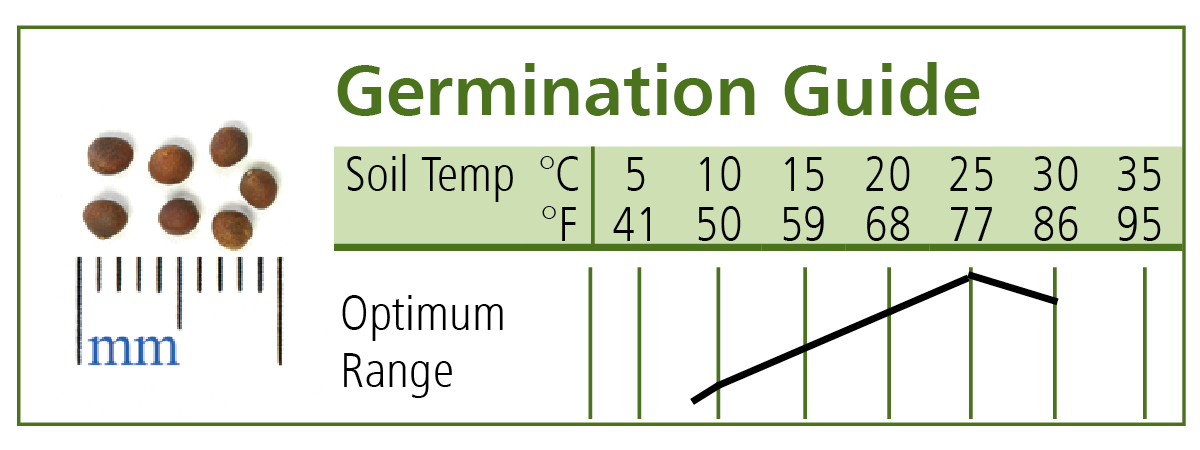Bonarda
(F1) Broccoli Seed
Product ID: 4579
Productive overwintering variety.
Cold-hardy mini broccoli with deep purple florets on narrow stems and very strong, upright plants. For late summer or early fall planting to overwinter and harvest in early spring. 3-week harvest window. Later maturity prevents floret damage from early spring frosts. NOTE: Vernalization (prolonged exposure to cold temperatures) is required for a successful crop. Bonarda will winterkill if unprotected and temperatures fall below 20°F (-7°C). High resistance to Fusarium yellows; and intermediate resistance to black rot. Avg. 104,600 seeds/lb. Packet: 100 seeds.
https://www.johnnyseeds.com/vegetables/broccoli/mini-broccoli/bonarda-f1-broccoli-seed-4579.11.html
Size
Price
Quantity
Availability
SCIENTIFIC NAME: Brassica oleracea (unless otherwise indicated).
CULTURE: Prefers a well-drained, fertile soil high in organic matter with a pH of 6.0–7.5. Prefers a consistent supply of moisture throughout the growing season. Irrigate regularly for best results.
DISEASES AND INSECT PESTS: Prevent flea beetle damage by applying floating row cover at planting. Flea beetles can also be controlled with insecticides such as azadirachtin or pyrethrin. Cabbage worms can be controlled with Bacillus thuringiensis. Prevent disease with crop rotation and good sanitation.
TRANSPLANTING: Sow 2 seeds per cell in 72-cell plug flats, 3–4 seeds/in. in 20-row flats, or in outdoor beds ¼" deep. Seedlings should be ready to transplant in 3–4 weeks. If possible keep soil temperature 75–80°F (24–27°C) until germination, then reduce air temperature to about 60°F (16°C). Ensure good air circulation and light. Transplant outdoors 6–12" apart for spring raab and 12–24" apart for sprouting broccoli in rows 18–36" apart.
DIRECT SEEDING: Sow 3 seeds per foot, ½" deep, rows 18–36" apart, thinning to one plant in each group.
COLD TREATMENT (VERNALIZATION): Late-sprouting varieties require exposure to temperatures at or below 50°F (10°C) to induce budding. See individual varieties for duration of vernalization period.
PINCHING: For some varieties, side-shoot production can be increased by pinching the initial head as soon as it forms. See individual varieties for pinching recommendations.
HARVEST: Before flower buds open, cut stems of central head and side shoots. Stems 4–8" in length can be bunched for sale or sold loose. Harvest regularly to encourage continued production.
DAYS TO MATURITY: Sprouting broccoli: From transplant date to central head harvest, side shoots will follow. Spring raab: From direct seeding.
SIZED SEEDS: "Sized" seeds have been sorted so they are roughly the same size. This consistency allows for more accurate spacing with mechanical seeders and more even germination. Broccoli seeds are sized, except when noted in the product description.
SEED SPECS: Seeds/lb. 52,900–142,100 (Avg. 104,100)
PACKET: 100 seeds, sows 50', unless otherwise noted.
CULTURE: Prefers a well-drained, fertile soil high in organic matter with a pH of 6.0–7.5. Prefers a consistent supply of moisture throughout the growing season. Irrigate regularly for best results.
DISEASES AND INSECT PESTS: Prevent flea beetle damage by applying floating row cover at planting. Flea beetles can also be controlled with insecticides such as azadirachtin or pyrethrin. Cabbage worms can be controlled with Bacillus thuringiensis. Prevent disease with crop rotation and good sanitation.
TRANSPLANTING: Sow 2 seeds per cell in 72-cell plug flats, 3–4 seeds/in. in 20-row flats, or in outdoor beds ¼" deep. Seedlings should be ready to transplant in 3–4 weeks. If possible keep soil temperature 75–80°F (24–27°C) until germination, then reduce air temperature to about 60°F (16°C). Ensure good air circulation and light. Transplant outdoors 6–12" apart for spring raab and 12–24" apart for sprouting broccoli in rows 18–36" apart.
DIRECT SEEDING: Sow 3 seeds per foot, ½" deep, rows 18–36" apart, thinning to one plant in each group.
COLD TREATMENT (VERNALIZATION): Late-sprouting varieties require exposure to temperatures at or below 50°F (10°C) to induce budding. See individual varieties for duration of vernalization period.
PINCHING: For some varieties, side-shoot production can be increased by pinching the initial head as soon as it forms. See individual varieties for pinching recommendations.
HARVEST: Before flower buds open, cut stems of central head and side shoots. Stems 4–8" in length can be bunched for sale or sold loose. Harvest regularly to encourage continued production.
DAYS TO MATURITY: Sprouting broccoli: From transplant date to central head harvest, side shoots will follow. Spring raab: From direct seeding.
SIZED SEEDS: "Sized" seeds have been sorted so they are roughly the same size. This consistency allows for more accurate spacing with mechanical seeders and more even germination. Broccoli seeds are sized, except when noted in the product description.
SEED SPECS: Seeds/lb. 52,900–142,100 (Avg. 104,100)
PACKET: 100 seeds, sows 50', unless otherwise noted.
Johnny's is committed to your success, every step of the way.
We want you, our customer, to be 100% satisfied with all of our seeds, tools, and supplies.
If anything you purchase from us proves unsatisfactory, we will either replace the item or refund the purchase price.



